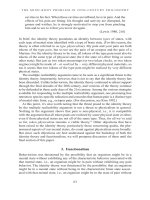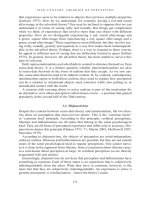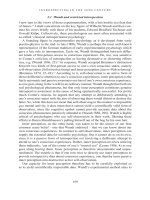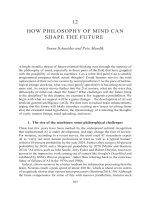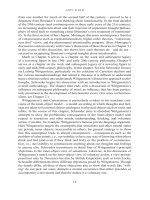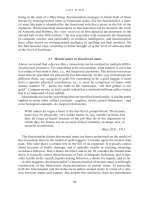Philosophy of mind in the twentieth and twenty first centuries the history of the philosophy of mind volume 6 ( PDFDrive ) (1) 302
Bạn đang xem bản rút gọn của tài liệu. Xem và tải ngay bản đầy đủ của tài liệu tại đây (172.39 KB, 1 trang )
C ognitive science in the 2 0 th century
2. The basic explanatory package
We do resent the hiatus between our mental terminology and our
physical terminology. It is being attacked in a very realistic fashion
today.
McCulloch 1943 (from the Warren S. McCulloch
Papers, cited in Piccinini 2004)
Cognitive science aims to explain agency in material terms – in particular, in
mathematical terms that bridge logic (mind) and engineering (matter). Oddly,
mathematics is frequently omitted from the list of disciplines contributing to
cognitive science even though many pioneers of cognitive science, including
Turing, Pitts, Wiener, and Shannon, were mathematicians. In contrast, neuroscience, philosophy, psychology, linguistics, and computer science are usually
listed as constitutive disciplines (e.g., Bechtel et al. op.cit., 69–70; Miller 2003,
143; Heckathorn 1989), even though (like mathematics) most areas of these disciplines have nothing to do with cognitive science. Anthropology is also included
even though it quickly parted ways from cognitive science (Bender et al. 2010).
Sociology or “sociocultural studies” (Bechtel et al. op.cit., 93) is mainly noted
for its absence (Bainbridge 1994, 408), underlining the lag in integrating social
aspects of cognition.
The omission of mathematics may be due to the fact that, until Turing, we
lacked an empirically plausible model of how the mind could be material. Without such a model, materialists could do little to counter the intuition, and philosophical position, that the mind is exempt from the mathematico-engineering,
mechanical explanation of the rest of nature. Gottfried Leibniz (a mathematician)
had the idea of a logical calculus in the 17th century, but he also denied that
perception and consciousness could be implemented in a machine (Monadology
17).3 With Turing’s breakthrough, we could retrospectively identify percursors –
more mathematicians. In the 18th century, Charles Babbage invented (but did not
fully build) an analytical engine for general computing that operated on the same
principles as the Jacquard loom, which used sequences of punchcards to organize
sequences of the machine’s weaving operations (Copeland 2008). George Boole
(1854) found that mathematical operations performed on sets could also be logical operators that operated on propositions or sentential thought contents, suggesting that the resulting operations were laws of thought. Gottlob Frege (1879)
added a logic that allowed for operations on parts of propositions, formalizing
deductive inference.
The study of these ideas, blended in mathematical logic, unified the conceptual founders of cognitive science (Aspray 1985). The ideas themselves provided
materialists with a clear engineering target: to build something that can do these
logical operations. Doing this would at least get the ball rolling.
283

